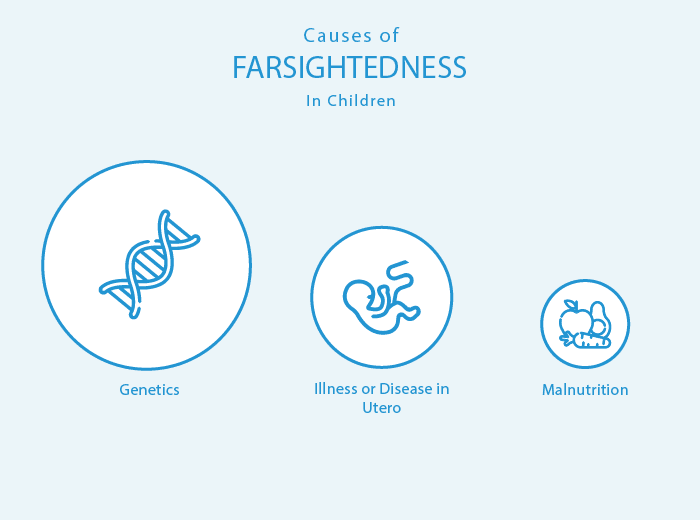Farsightedness in Children: Causes, Diagnosis & Treatments
Home / Farsightedness (Presbyopia) /
Last Updated:
Hyperopia in children is a significant concern, as it is one of the most common forms of refractive errors affecting young populations in the United States. Around 21 percent of children between the ages of 6 months and 6 years old, as well as 13 percent of children aged 5 to 17, are affected by hyperopia, commonly known as farsightedness.
Table of Contents
Hyperopia is a hereditary condition that runs in families. Children are often born with it, and it can commonly go unnoticed as the eyes can correct themselves and blurry vision may not be an issue.

Farsightedness can lead to learning difficulties and eye strain. It can cause accommodative esotropia, which is when the eyes cross to try to make up for the refractive error, when left untreated. As a result, it’s helpful to know what to look for.
A comprehensive eye exam, using specialized equipment and performed by a trained professional, can be used to diagnose farsightedness in children. Farsightedness in children is most commonly treated with eyeglasses, although in some cases, corrective surgery may be an option.
Factors Contributing to Farsightedness in Children

Farsightedness occurs when light is focused behind the retina instead of directly on it. This can occur because the eyeball is too short or there is not enough depth on the cornea.
The American Academy of Ophthalmology (AAO) publishes that the majority of children are farsighted since the eye is not fully developed. Most children’s eyes are able to correct and accommodate for mild hyperopia, however. Their eyes are able to bend the light entering the eyes in such a way that they can focus it onto the retina, thus increasing focus and eliminating blurry vision.
Mild hyperopia in children is common. It often does not create any issues, as children can accommodate for it and generally be able see clearly near and far. As children age, their eyes lengthen, and farsightedness can therefore improve on its own.
Refractive errors, such as nearsightedness and farsightedness, are some of the most common vision impairments in the world. The journal Clinical Genetics explains that genetics play a role in both.
Hyperopia, or farsightedness, is considered to be highly heritable. Twin and genetic studies have shown genetics to play a role at least half of the time, though often a much higher incidence is present. This means that if a parent suffers from hyperopia, it is highly likely that their biological child will as well.
Complications in utero or early childhood that influence growth and development, such as illness or disease, can increase the risk for hyperopia. Trauma to the eye can also be a risk factor for farsightedness as well.
The American Optometric Association (AOA) explains that environmental factors, such as malnutrition, can contribute to hyperopia, but not as commonly as they can for myopia. In general, hyperopia in children is most often related to whether or not it runs in the family.
Diagnosing Childhood Farsightedness
Farsightedness in children regularly corrects itself and does not cause problems, but when hyperopia is more severe, it can lead to trouble paying attention in school, behavioral issues, and even additional eye problems.
Crossed eyes, or accommodative esotropia, occurs when one eye is trying to make up for the refractive error in the other, causing the eyes to cross. It often occurs as a child gets tired and is trying to focus on something up close; you may notice the eyes crossing inward as they do so. Eye rubbing and squinting are common symptoms of accommodative esotropia in young children, and older children may complain of headaches as well.
AAO publishes that the average onset of accommodative esotropia is around age 2.5, though it can develop as early as 6 months and as late as 7 years old. Accommodative esotropia can be an indicator of hyperopia in a child.
There are other symptoms of farsightedness in children.
- Headaches
- Blurry vision when focusing on items up close
- Eye strain
- Fatigue
- Trouble reading
Hyperopia Screening and Testing
Here are some of the techniques that an optometrist can use to detect hyperopia in a child:
Visual Acuity Tests
This eye exam can help assess your child’s visual clarity or sharpness. The eye specialist will ask your child to read from a chart with rows of symbols or shapes, such as letters.
The symbols will be about 10 feet away and will keep getting smaller line after line. First the child will read with both eyes open, then with one eye closed.
Children under 3 years aren’t ideal candidates for this test as they’re generally uncooperative.
Retinoscopy
The purpose of this test is to diagnose farsightedness or nearsightedness by observing the reflection of light off the patient’s retina. During this process, an optometrist uses a retinoscope to shine light into your child’s eye.
They’ll keep swinging the hand-held instrument horizontally and vertically across the eye while monitoring the reflection. An instrument called a phoropter can then measure the exact level of refractive error present to determine the best course of treatment.
As retinoscopy isn’t invasive or painful, your child won’t usually need anesthesia to have it. However, general anesthesia may be necessary if the minor keeps closing their eyelids during this test.
Eye Disease Exam
This test can help an ophthalmologist determine whether an eye disease is causing your child’s vision challenges. During the exam, the specialist will administer drops into the eyes to widen (dilate) the pupil.
Dilated pupils give the doctor a better view of the child’s eyes. Other eye tests may be incorporated to provide a conclusive diagnosis.

Treatments for Farsightedness in Children
Typically, farsightedness in children does not need correction, as the eyes can accommodate for the refractive error on their own. Essentially, the focusing muscles are able to ensure clear vision, both far and near, the American Association for Pediatric Ophthalmology and Strabismus (AAPOS) explains. If hyperopia is extreme and causing blurred vision, crossed eyes, or other discomfort, treatment can be beneficial.
Farsightedness in children can be corrected with prescription eyeglasses. Glasses can be fitted directly to the child, and the prescription matched accordingly. Children may only need to wear corrective lenses when reading or focusing on close-up items. Accommodative esotropia may be treated with bifocals, which are specialized glasses that can correct for both types of refractive errors (farsightedness and nearsightedness).
Children’s glasses should fit their faces. They often have soft, comfortable, and flexible frames around the ears and shatterproof lenses. Contacts may be an option as well, but these are typically reserved for older children and usually more suited for treating myopia than hyperopia.
The U.S. Food and Drug Administration (FDA) does not approve laser eye surgery for children under the age of 18. Since farsightedness in children is often a condition that is grown out of, a permanent change to the eyes at a young age is generally not necessary.
The journal Review of Ophthalmology reports that there are some extreme cases where corrective refractive surgery may be an option for children, such as when traditional treatments are not working and the condition is severe enough to warrant it. Procedures such as LASIK (laser-assisted in-situ keratomileusis) and PRK (photorefractive keratectomy) may have to be repeated a second or third time if done prior to adulthood since the eyes can grow and change.
For this reason, unless it is specifically necessary, as determined by a doctor, laser eye surgery is generally not considered in the treatment plan for children with farsightedness. Glasses or contacts that can be readjusted as needed are typically more suitable.
You deserve clear vision. We can help.
With 135+ locations and over 2.5 million procedures performed, our board-certified eye surgeons deliver results you can trust. Your journey to better vision starts here.
References
- Prevalence and Impact of Vision Disorders in U.S. Children. Prevent Blindness.
- Farsightedness. (June 2018). Mayo Clinic.
- Farsightedness: Causes of Hyperopia. (March 2014). American Academy of Ophthalmology.
- Genetic Susceptibility and Mechanisms for Refractive Error. (August 2013). Clinical Genetics.
- Strabismus: Accommodative Esotropia. (January 2016). American Academy of Ophthalmology.
- Farsightedness: Hyperopia Diagnosis. (March 2017). American Academy of Ophthalmology.
- Glasses for Children. (November 2015). American Association of Pediatric Ophthalmology and Strabismus.
- When Is Refractive Surgery Right for Children? (May 2010). Review of Ophthalmology.
- Should Glasses Be Prescribed for All Children with Moderate Hyperopia? Ophthalmology. Date Fetched: July 17, 2021
- Eye Screening for Children. American Academy of Ophthalmology. Date Fetched: July 17, 2021
- Vision Screening. American Association for Pediatric Ophthalmology & Strabismus. Date Fetched: July 17, 2021
- Retinoscopy. American Association for Pediatric Ophthalmology & Strabismus. Date Fetched: July 17, 2021
This content is for informational purposes only. It may have been reviewed by a licensed physician, but is not intended to serve as a substitute for professional medical advice. Always consult your healthcare provider with any health concerns. For more, read our Privacy Policy and Editorial Policy.